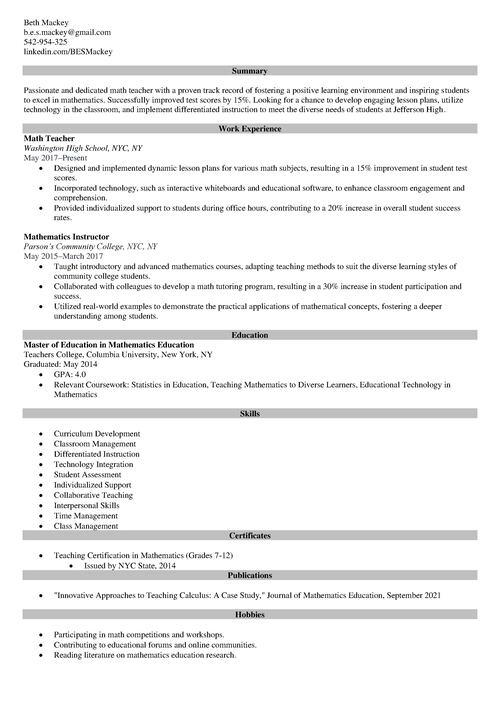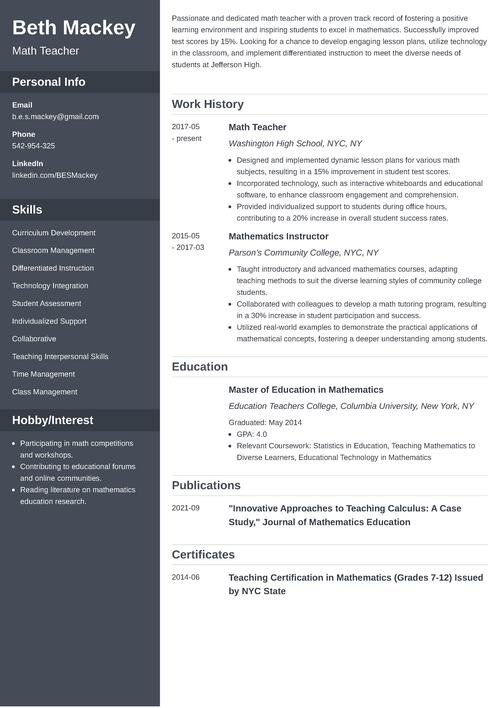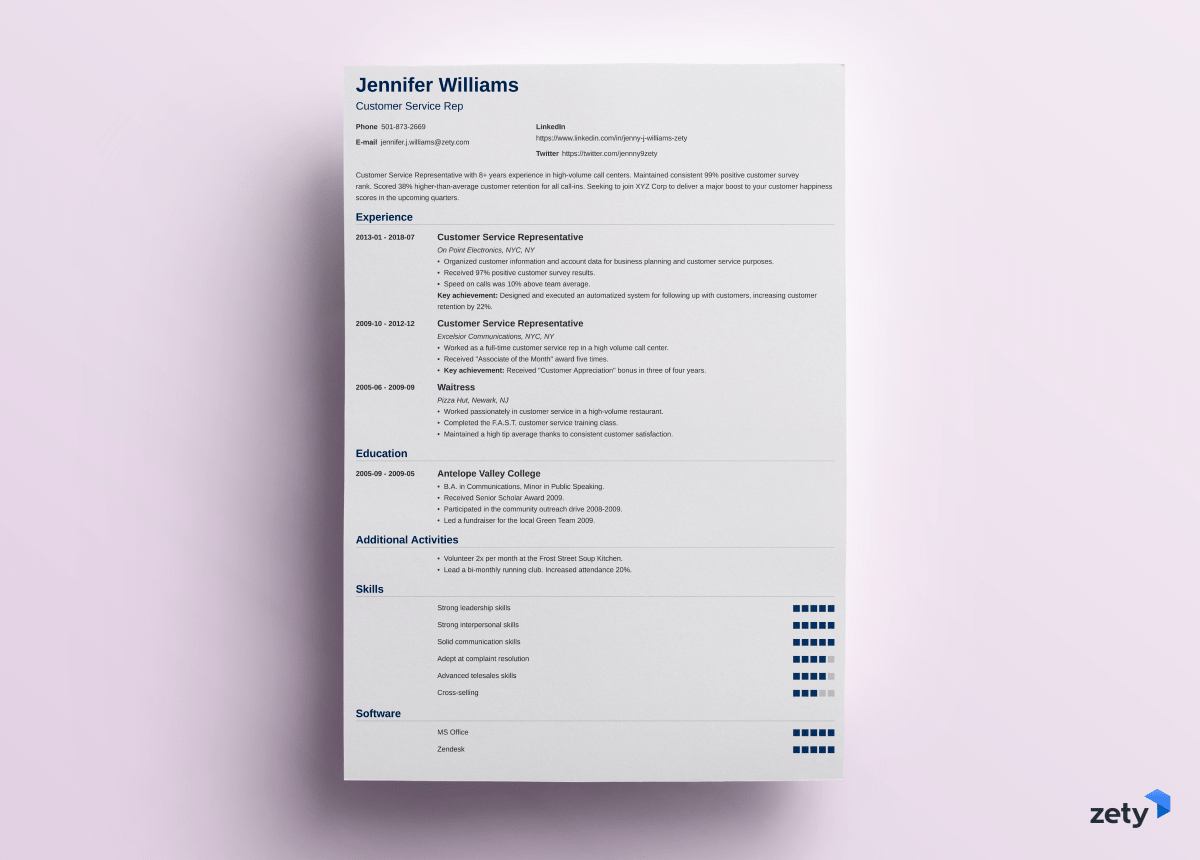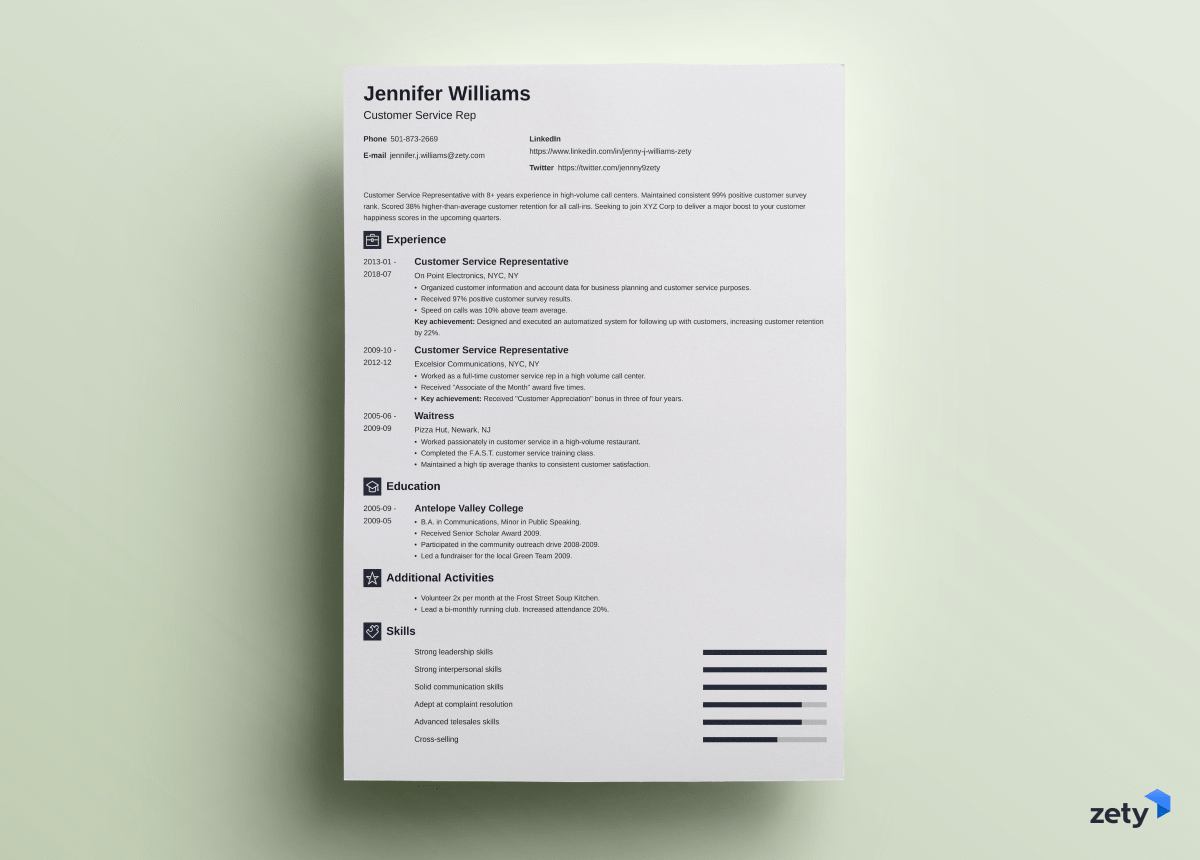What to Put on a Resume: Best Things To Include in 2025
Create Your Resume NowThere are many things to put on a resume. Work experience and education seem like the must-haves of every resume. But then there’s a skills section. And Additional sections. And a summary. Or an objective. And what about the header, what should it consist of?
It’s not that tricky. If you’re wondering what to include on a resume, we’re here to answer this question. So let’s make it clear once and for all!
This guide will show you:
- What to put on a resume to impress recruiters.
- What NOT to put on a resume if you want to boost your chances of landing an interview.
- What goes on a resume apart from must-have sections?
- 5+ resume templates that include all the necessary sections of a perfectly-crafted resume.
Want to save time and have your resume ready in 5 minutes? Try our resume builder. It’s fast and easy to use. Plus, you’ll get ready-made content to add with one click. See 20+ resume templates and create your resume here.
Sample resume made with our builder—See more resume examples here.
1. What to Include on a Resume: Key Elements
A recruiter will most likely look at your resume for about 7 seconds. There are certain sections they must see:
- Header
- Work Experience
- Education
- Skills
- Additional sections
A good resume should consist of these resume sections and categories. That’s how you make sure your resume can help you impress the recruiter, secure a job interview, or even win the opening you’re after.
So, without further ado, let’s go through all the key sections you should put on your resume:
Are you looking for a step-by-step guide on writing a resume? Look no more, it’s right here:How to Write a Resume
1. Resume Header With Contact Information
What goes on a resume first is something you don’t want your recruiter to miss. It’s the header, and it includes the basic contact information on your resume.
Here’s what should be in a resume header:
- Your name
- Professional title
- Phone number
- Professional email
- Social media handles (Twitter and LinkedIn)
- URL to your personal website, blog, or portfolio
Adding your address is optional these days, especially if you are applying for a job in a different state or country. If the job you’re applying for is not local, excluding your current address will help you avoid confusion.
And that’s all you need to start with. Let’s see what are other things to put on a resume!
Pro Tip: Whenever you update your contact information, don’t forget to update it on your LinkedIn Profile as well. Recruiters will check your online presence, and so should you!
2. Resume Summary or Objective
Tricky question—what should be on a resume after your contact information? Do you jump straight into your experience section or give your recruiter a brief introduction?
You guessed it. Giving a brief introduction will allow your recruiter to better filter more than 250 resumes that land on their desk.
Starting a resume with a summary or objective is a golden opportunity. Both are short, snappy introductions that should highlight your career progress and skill set.
And if you don’t have much career progress, write two or three lines that tell a recruiter where you are and where you’re going professionally.
Writing a professional resume career summary isn’t easy, and it’s even harder when you’re trying to figure out how to write a resume objective.
But which do you choose?
The resume objective is better for writing:
- Student Resume
- Scholarship Resume
- Internship Resume
- Entry-Level Candidates Resume
- No-Experience Resume
- Career Change Resume
To structure your objective, use the following formula:
Adjective(s)/Certificate(s) + Your Job Title or Degree + seeking employment as + Position Name at + Company Name + to apply my + Your Relevant Skills + to help + What Do You Want To Help The Company Achieve
If you haven’t found yourself in the list above, you should write a’ professional resume summary.
It’s great for highlighting at least a year of work experience, during which you could have achieved some goals worth mentioning on your resume.
To structure your resume summary, use the following formula:
Adjective + Job Title + Years of Experience + Achievements + Skills + What You Want to Do for the Employer
That will guarantee you a great opening for your resume!
The most important thing to keep in mind when writing both is that you no longer tell an employer what you want. You can actually boil it down to just a few words using our formula for resume titles.
Instead, you tell them that you’re going to give them what they want.
3. Experience Section
The experience section is going to make up the body of your resume. It’s perhaps the most important part of your document for many recruiters. So you have to make sure it’s done perfectly!
To ace it, you do not need to list every job you've ever had. Only add jobs that you had in the past ten or fifteen years or are relevant to the job for which you are applying. Just don’t leave large gaps in your job history.
Also, follow the reverse chronological resume format, as it allows you to highlight most recent activities and accomplishments.
So, what to include in a resume experience section?
- A list of relevant jobs.
- Up to six bullet points describing your roles and responsibilities at each job.
- Achievements illustrated with facts and figures.
- Action verbs to help you stand out more.
- Name and location of each company and work period.
- Internships.
And that’s how you ace an experience section.
Pro tip: Whatever important information you find in the ad is potentially a keyword for your resume.
Making a resume with our builder is incredibly simple. Follow our step-by-step guide, use ready-made content tailored to your job and have a resume ready in minutes.
When you’re done, Zety’s resume builder will score your resume and our ATS resume checker will tell you exactly how to make it better.
4. Education Section
Your education section can either come after your experience section, or you can add it before if you've recently graduated.
What should be on a resume education section?
- List of your degrees and schools. Your education section is also written in reverse-chronological order, with your most recent degree appearing first. If you have higher degrees, you do not need to add the high school you attended.
- Description of your course of study. You don’t have to add a description of what you studied, but you can include relevant coursework on your resume.
- Any honors and awards you received. A typical entry in your education section should include your type of degree, your major, the name of your university, and any latin honors and awards you received like this: And don’t forget about extracurricular activities!
Honors BA in English Literature, Purdue University, Salutatorian
Pro Tip: You can skip GPA on a resume if you’re a professional, and you can add it if you’re a student and it’s a 3.5 GPA or higher.
5. Skills
Your skills section is a list of your best skills. Make sure that you list up to ten skills from the job description as possible. These are your resume keywords, and they are not only what recruiters want to see. They boost your chances of creating an ATS-friendly resume that will pass Application Tracking Systems used to filter resumes before they reach recruiters’ desks.
But besides the keywords from the job offer, what skills need to go on a resume?
Here are the skills that are some of the good things to put on a resume:
- Computer Skills
- Communication Skills
- Leadership Skills
- Organizational Skills
- People Skills
- Customer Service Skills
- Collaboration Skills
- Problem-Solving Skills
- Interpersonal Skills
- Creative Thinking Skills
- Critical Thinking Skills
- Management Skills
- Teamwork Skills
- Active Listening Skills
- Adaptability Skills
- Negotiation
- Conflict Resolution
- Empathy
- Decision-Making Skills
- Time Management Skills
- Language Skills
- Administrative Skills
You will want to scatter your skills throughout your experience section and put your best hard and soft skills in your skill section.
6. Hobbies
Adding a hobbies and interests section to your resume is a very good idea, especially if you’ve got extra space. Many companies are now placing more of an emphasis on personality and how well they think you’d fit in with their team and the company’s culture.
You don’t have to add a hobby section, but it’s a great way to show off your personality and set yourself apart. It is definitely something that you should consider including on a resume. Especially, since some hobbies can prove you’ve got some specific skills. For example, being a team player can be confirmed by putting “playing hockey” in your hobbies section.
7. Other Additional Sections
Besides a Hobbies and Interests section, there are other extra sections you could consider including on your resume.
- Certifications and licenses will work perfectly, as they send a simple message: this person can also do that and is certified or licensed to do it!
- Language skills are also impressive, as you might always find yourself in a multinational company.
- Volunteering experience looks great to hiring managers.
- Relevant Publications: That’s not how you show you’re a pro. That’s one level up. By listing your publications, you show you’re an authority.
- Resume Professional References: You probably have some colleagues or superiors who are willing to say a few nice words about you. Asking them for references will allow you to add some human touch to your resume.
Whatever you decide to add, just make sure that it doesn't overwhelm your resume or comprise your resume length.
And that’s pretty much all you need to know about what goes on a resume.
So maybe let’s take a look at what should be on a resume if you don’t want to get hired. Or, in other words…
8. Tailor Your Resume To a Job Description
Remember to tailor your resume to the job description—this point is crucial.
The skills and experience listed in the job description are what recruiters look for when they initially scan your resume. Add keywords from the job description throughout your resume.
It's also a good idea to add most of the skills verbatim. Put them in your experience or your skills section. When hiring manager sees words from the job description, they will know that your resume is relevant and that you have the skill set they want in a potential candidate.
Tailoring your resume to a specific job is vital. That’s how you make it personal and that’s how you show them your admiration and appreciation.
Pro tip: You probably have some colleagues or superiors that are willing to say a few nice words about you. Asking them for professional references will allow you to add some human touch to your resume.
2. Resume Templates That Include All the Key Sections
Putting together a resume is a tough and time-consuming process. Luckily, you can take some (or most!) of the hassle out of it. Just pick one of Zety’s templates. This way, you’ll make sure your resume includes everything that’s necessary, plus, you’ll get tips and ready-to-use contents for every section.
1. Nanica
The best thing about this template? All key sections are noticeable in a flash thanks to big section headings. It helps you bring attention to what matters most. Also, this resume design is conservative and simple—recommended for corporate job applications.
2. Primo
Another layout that helps you include everything in an organized manner. Primo features a timeline for your work history and education, making it super easy to navigate through your career progression. All the necessary sections are highlighted with tiny icons. Two columns make it easier to fit more information onto a single page. This template is very versatile: will work for traditional as well as creative jobs.
3. Cubic
Another resume that helps you organize all the items better thanks to the double-column layout. Want to put more extra information on a resume? Courses? Additional activities? Certifications? With Cubic, you can include all that and still send out a one-pager. A good template for senior candidates.
4. Diamond
This resume style is most popular amongst job seekers in business and finance. Again, the most important pieces of information are prominent thanks to professionally-looking headings.
5. Newcast
Last but not least—Newcast. This resume template will help recruiters easily skim through all the necessary sections going from top to bottom. One of the most minimalist-yet-elegant resumes on our offer, nothing gimmicky, traditional layout, lots of white space—an ideal pick for academic admission applications or jobs in research.
3. Tailor Your Resume To a Job Description
Remember to tailor your resume to the job description—this point is crucial.
The skills and experience listed in the job description are what recruiters look for when they initially scan your resume. Add keywords from the job description throughout your resume.
It's also a good idea to add most of the skills verbatim. Put them in your experience or your skills section. When hiring manager sees words from the job description, they will know that your resume is relevant and that you have the skill set they want in a potential candidate.
Tailoring your resume to a specific job is vital. That’s how you make it personal and that’s how you show them your admiration and appreciation.
So now, let’s try to answer an important question.
Plus, a great cover letter that matches your resume will give you an advantage over other candidates. You can write it in our cover letter builder here. Here's what it may look like:
See more cover letter templates and start writing.
Key Takeaway

Keep these points in mind as you are making your resume:
- Not everyone’s perfect resume is going to look the same.
- While a standard resume will include contact information, experience, and education, the skills and achievements you add will differ based on your job offer.
- Remember that when you are trying to decide what to put on your resume your job description is your best friend. It tells you exactly what a hiring manager expects to see on your resume.
If you don’t include anything else on your resume make sure you add keywords, skills, and experience from your job offer and you can be sure that your resume is practically perfect in every way.
About Zety’s Editorial Process
This article has been reviewed by our editorial team to make sure it follows Zety's editorial guidelines. We’re committed to sharing our expertise and giving you trustworthy career advice tailored to your needs. High-quality content is what brings over 40 million readers to our site every year. But we don't stop there. Our team conducts original research to understand the job market better, and we pride ourselves on being quoted by top universities and prime media outlets from around the world.
Sources
- HR Dive, "Eye-tracking study shows recruiters look at resumes for 7 seconds"
- Glassdoor, "50 HR and recruiting stats"
Frequently Asked Questions about What to Put on a Resume
What are good skills to put on a resume?
Here are some good skills to put on a resume for just about any job:
- Communication skills
- Teamwork / Collaboration skills
- Interpersonal skills
- Leadership skills
- Computer skills
- Problem-solving skills
- Hard skills specific to your job. Those are the technical skills and core competencies required to succeed in the role (unlike soft skills, which are more universal). For example, for office jobs, you’d list specific administrative skills, and for retail jobs—customer service skills.
Still not sure what skills to put on a resume? Take another look at the job ad: it should mention specific hard and soft skills the company’s looking for. Those can make for great resume keywords and boost your chances of success, so make sure to include all of them in your job application. You can also check out our 500+ resume examples to find a sample resume for your role and see a list of professional skills specific to your job.
What to include in a resume?
Here’s what to put on a resume:
- Resume header with your contact information
- Resume summary (also known as a summary of qualifications)
- Work experience section—for each entry, put your job title, the name and location of the company, and the dates you worked there. Add 4–6 resume bullet points with a job description that features your best on-the-job achievements.
- Education section—put only your highest level of schooling; add more details if you don’t have much work experience.
- Additional resume sections—good things to put on a resume include language skills, relevant certifications and licenses, or volunteer work experience.
For more details on what to put in a resume, check out our guide on how to make a resume and see what a resume should look like. To speed things up, head over to our resume builder: it features ready-made professional resume templates, pre-written phrases tailored to your job title, and a wizard that’ll help you write your resume in just minutes!
What to put on a resume with no experience?
Here’s a quick set of tips for writing a resume with no work experience:
- Use a resume objective instead of a resume summary. It focuses on what you plan to achieve and highlights your enthusiasm and motivation.
- Focus on showing your transferable skills, i.e. useful skills you’ve picked up outside of work, but which will help you succeed in your chosen career (e.g. communication or teamwork developed while at school).
- Expand your education section with extra details, such as relevant coursework, achievements, GPA (if your GPA was high enough for a resume, so 3.5+), and extracurricular activities that show your skills.
- Highlight any other experience you have, such as volunteer work, internships, freelancing, or personal projects relevant to the job.
For more advice, see this entry-level resume example and writing guide, as well as our student resume guide and high school resume templates.
What not to put on a resume?
Here’s what not to include in a resume:
- Personal details such as your marital status or religion. Employers are not allowed to ask you about these things, and there’s no reason to include them in your application.
- Headshot—don’t include your picture on a resume unless you’re applying for a modeling or acting job.
- Unrelated skills or hobbies—interests are fine on a resume, but only if they’re somehow relevant to the job. Check out this article about hobbies on a resume for more details. Your skills section should only contain skills mentioned in the job ad and/or necessary to do the job well.
- Your full address—employers don’t need it at this point.
- Irrelevant experience—if you have relevant experience already, there’s no need to list any irrelevant jobs you’ve held. The only exception is if you’re writing a resume with little to no experience.
- Unnecessary details—the best length for a resume is one page, so it’s important to stick to only the most relevant information that directly speaks to your suitability for the role.
How far back should a resume go?
Not sure how many jobs to put on a resume? As a rule of thumb, stick to 10–15 years of relevant experience. If there’s something further back in your work history that really needs highlighting, mention it briefly—it’s likely that your more recent experience will be more relevant. Keep in mind that for most jobs, it’s best to submit a one-page resume—so your space is severely limited. Go for a two-page resume only if you’re applying for senior jobs and have lots of relevant achievements. The only exception to all of the above is the academic CV, used when applying for jobs in academia, which can go on for several pages and cover 15+ years.









